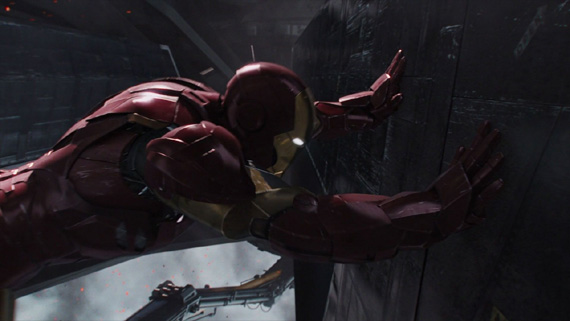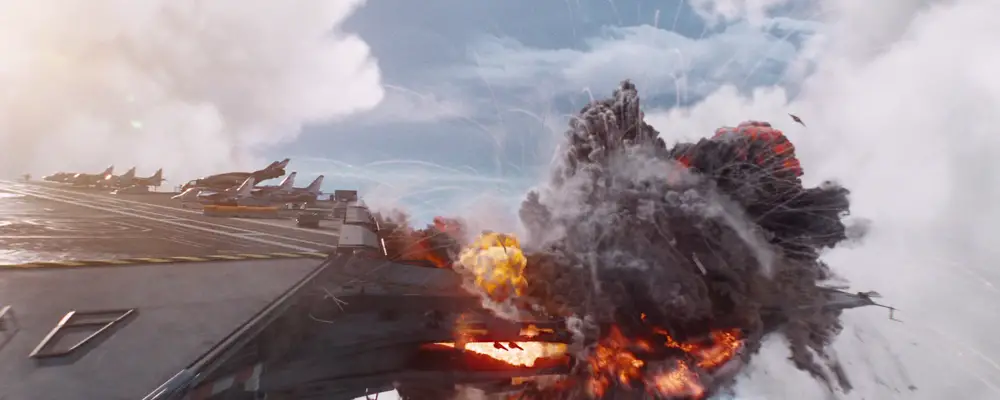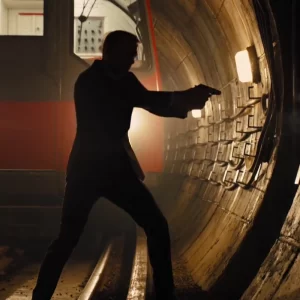Inside Weta Digital’s Explosive Work On ‘The Avengers’ Helicarrier
The Helicarrier is the setting for the Avengers’ first fight as a team. Well all most. Hawkeye, under the control of Loki, leads an attack on S.H.I.E.L.D.’s Flying Fortress, disabling one of the ship’s turbines with a well-placed arrow that is packed with explosives. The explosion doesn’t take down the Helicarrier, but it does blow a massive hole in the side of the ship. Weta Digital developed the VFX for this sequence and also the subsequent attempt by Iron Man and Captain America to jumpstart the damaged rotor.
Guy Williams, Weta’s visual effects supervisor on the film, spoke with FX Guide about the various VFX elements that went into each sequence.
Adding More Detail To ILM’s Helicarrier
Both sequences involved using ILM’s Helicarrier and Quinjet assets, which the New Zealand-based VFX company added detail to for close-ups. While Weta gave Hawkeye’s Quinjet a new paint job to distinguish it as a rogue jet from S.H.I.E.L.D.’s fleet, the Helicarrier received a lot more attention.
“…[W]e took ILM’s model of the Helicarrier and dressed in a lot of dressing,” said Williams. “So we had lots of little pieces of the Helicarrier that we could then paint back onto it. So when we got into a close-up we would add double the amount of polygons that you’re seeing in the frame, and all these little piping and boxes and hatches detail all over the surface. The closer you got to it, you still felt like you were getting more detail.”
Weta also created their own specific builds for views of the Helicarrier, including Hawkeye’s arrow penetrating the engine before the explosion and the hole in the side of the ship where Iron Man and Cap attempt to re-start the rotor.
The Turbine Explosion
Weta created the turbine explosion as a high-resolution fluid sim. “…[T]he tools have come so far that the explosion of engine three was all done in one simulation, in one fluid cache,” said Williams. “The advantage of that – it’s actually 5 or 6 little explosions – but each one is actually interacting with the other one and lighting it. So as an explosion is propagated, the next one along would actually push that out of the way instead of just colliding with it.”
“The big explosions and smoke columns were simulated with Maya fluids in an alternate file format for sparser data,” continues Williams. “Most of the other fluid effects like dust, hydrogen leaks, Iron Man’s thruster exhaust – we simulated in Unagi, an in-house solver we use through our volume/particle framework called Synapse. Synapse is currently our main workhorse for large scale fluid and particle simulations. It’s a bit like a sophisticated level set compositing tool connected to our in-house solvers.”
Cap And Iron Man Attempt To Jump-Start The Damaged Turbine

Iron Man pushes the rotor to jump-start the Helicarrier’s damaged turbine.
Considerably more work went into Captain America and Iron Man’s work on the Helicarrier’s damaged engine. The massive hole ripped into the side of the Helicarrier is a potential death trap for the two characters. Cap has to ward off mercenaries with the real possibility of being sucked out through the hole 10,000 feet or so up in the air. While Iron Man has thrusters to keep him airborne, it’s a close call when he gets sucked under the turbine’s massive blades when he finally jump-starts it.
To create this scene, Weta modeled parts of this damaged area, which were given to ILM. They also needed digital doubles of both Iron Man and Captain America. From here, detailed models of the engine and rotor blades were created for Iron Man to jump-start.
“The model from ILM was so beautiful but it was never meant to be viewed from that close, so we got to go in and show what was inside it,” said Williams. “We took the stuff in the script that called it a Maglev section and embedded a bunch of these copper magnets in the tips of the blades and also along the wall, and then hid them by carbon fiber appliqués that went over the top of them so it still looked a relatively smooth wall, but the damage would blow away an entire section of the panel, so you’d see all these banks of copper magnets.”
Weta did all the Iron Man work on the Helicarrier. While he performed his usual antics such as flying and hovering while stabilized by his thrusters, new actions were required. Weta used digital creations of ILM’s Iron Man CG model to push the rotor round and round, and then when it started for they created shots of Stark being pulled underneath the rotors and dragged along the metal casing of the turbine. Williams added that little touches were important to the scene such as sparks. Fluid sims were used to create the liquid nitrogen coming out of the pipe Iron Man is working on. “The fluid interacts with Iron Man as he’s working, and is buffeted by the wind. All the pieces had to support each other and feel like they were there on the day.
As stated, Weta worked closely with ILM. Jeff White, ILM’s visual FX supervisor, explained to Flickering Myth, that they developed different types of damage for Iron Man’s various suits. In the Helicarrier sequence, when Stark gets pulled under the rotor, his suit incurs specific type of damage that looked like “scraped away paint and gouges.”
Clouds Are Just As Important As Explosions
While Weta put a lot of attention into crafting all this mayhem in the frame, they also spent considerable time developing volumetric clouds. Just as the little touches like sparks and scraped away paint sell Iron Man being dragged under a rotor, so too do clouds add necessary realism to sell the overall scene as both background and even foreground elements. In the foreground, Weta added a faint trail of volumetric clouds to give the impression which direction the Helicarrier is flying.
Weta developed 5 km of clouds and used light scattering to give the clouds a natural look. “The clouds have light scattering approximation,” explained Williams. “You get that bleed through the cloud with the light scattering and bouncing from one surface to another. So if you have a bright light shining on a cloud it will actually indirectly light the other parts of the cloud.”
Specifically, Weta used isometric scattering which brought out the detail in the clouds. “It’s because light doesn’t scatter sideways and even out on the values – it scatters into it,” explained Williams. “In real life, if you’re looking at a cloud and light’s behind you, it’ll look like the cloud has a dark edge to it. It’s because the light is absorbing. The thicker the cloud gets the more light goes into it. It’s also why when you look at a cloud and the sun’s behind it, you get a white line all the way around. The edge of the cloud scatters light more towards the viewer than the center does.”




